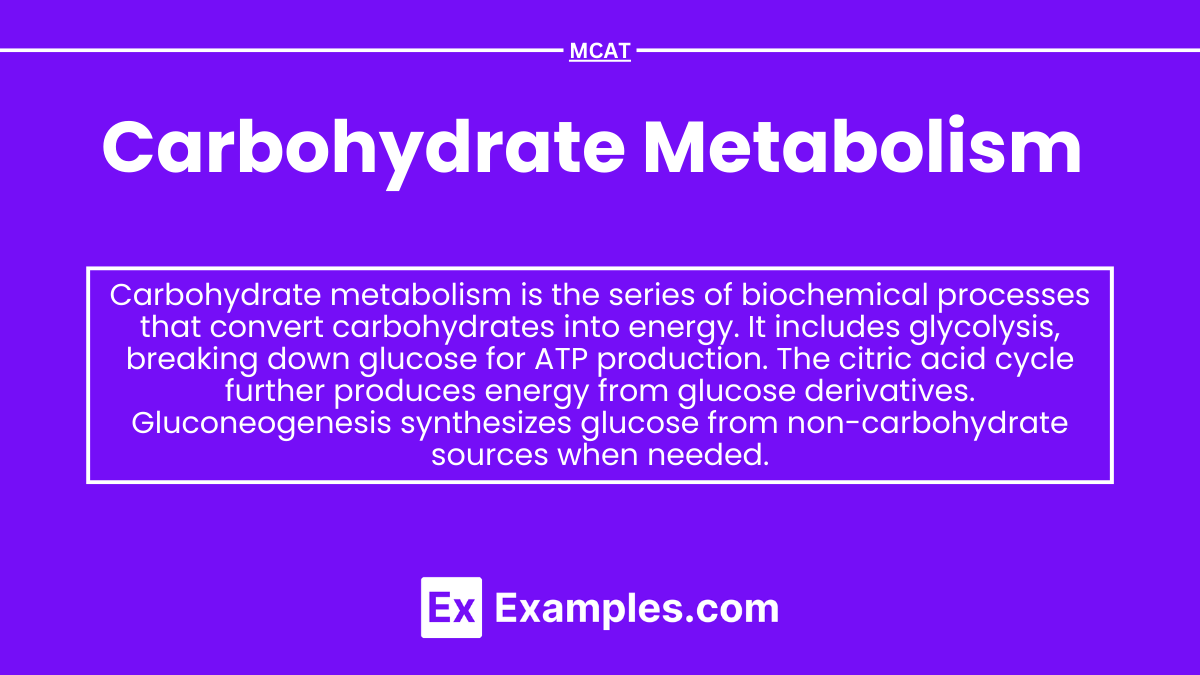Carbohydrate Metabolism

- Notes
Preparing for the MCAT involves mastering carbohydrate metabolism, a fundamental concept in biochemistry. This topic encompasses the breakdown, synthesis, and regulation of carbohydrates, focusing on processes such as glycolysis, gluconeogenesis, glycogenesis, and glycogenolysis. It also includes understanding how carbohydrates are utilized to produce ATP and how they are regulated by hormones like insulin and glucagon. A strong grasp of carbohydrate metabolism is crucial for achieving a high score on the MCAT, as it is closely linked to energy production, cellular communication, and metabolic homeostasis.
Learning Objectives
When studying “Carbohydrate Metabolism” for the MCAT, your learning objectives should include a detailed understanding of how carbohydrates are digested, absorbed, and metabolized to provide energy to cells. You should focus on mastering the pathways of glycolysis, glycogenesis, glycogenolysis, gluconeogenesis, and the citric acid cycle, with an emphasis on their steps, regulation, and integration in energy production. Additionally, learn about the roles of enzymes, coenzymes, and intermediates in these pathways, as well as how hormones like insulin and glucagon regulate carbohydrate metabolism. Grasping the differences between aerobic and anaerobic conditions, ATP yield calculations, and the role of carbohydrates in various physiological states (e.g., fasting, exercise) is essential for the MCAT.
Key Processes of Carbohydrate Metabolism
1. Glycolysis

- Location: Cytoplasm of cells.
- Process: Glycolysis is the initial pathway of glucose metabolism, converting one glucose molecule (6-carbon) into two pyruvate molecules (3-carbon), generating a small amount of ATP and NADH.
- Key Enzymes: Hexokinase, phosphofructokinase-1 (PFK-1), and pyruvate kinase.
- Regulation: PFK-1 is the rate-limiting enzyme, regulated by ATP levels and the presence of fructose 2,6-bisphosphate.
- Significance: Produces ATP anaerobically (without oxygen) and provides intermediates for other metabolic pathways.
2. Gluconeogenesis
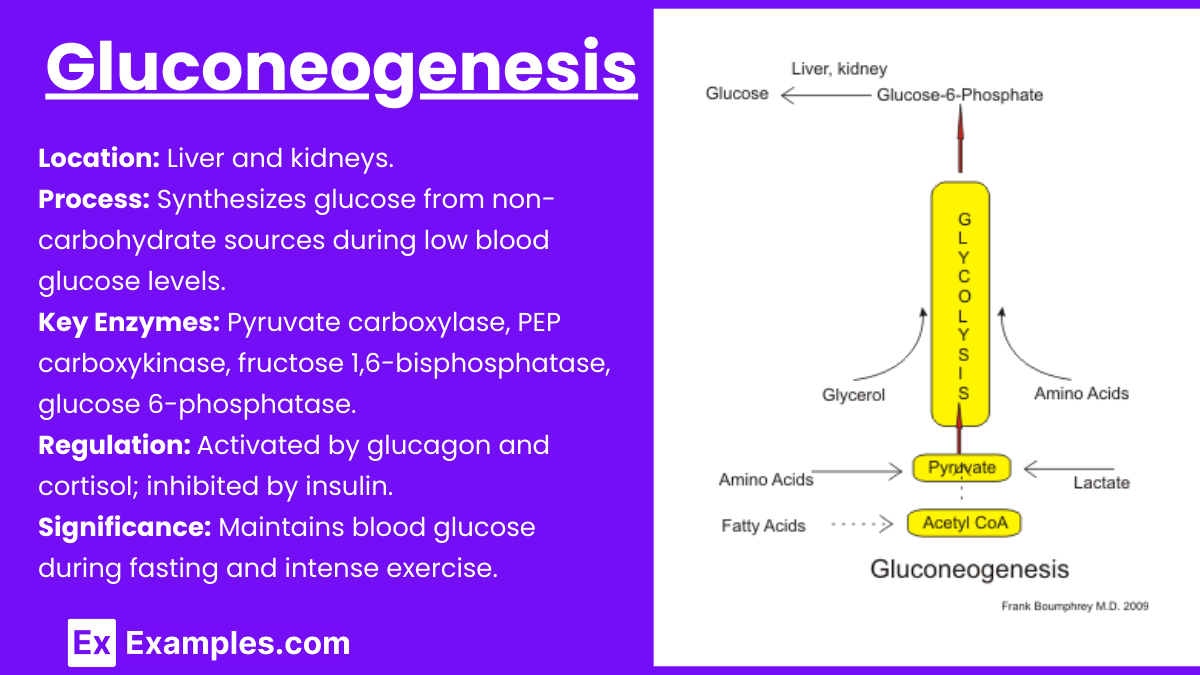
- Location: Liver and, to a lesser extent, kidneys.
- Process: This is the synthesis of glucose from non-carbohydrate sources (e.g., lactate, amino acids, glycerol), occurring when blood glucose levels are low.
- Key Enzymes: Pyruvate carboxylase, PEP carboxykinase, fructose 1,6-bisphosphatase, and glucose 6-phosphatase.
- Regulation: Activated by glucagon and cortisol during fasting; inhibited by insulin.
- Significance: Maintains blood glucose levels during fasting and intense exercise.
3. Glycogenesis
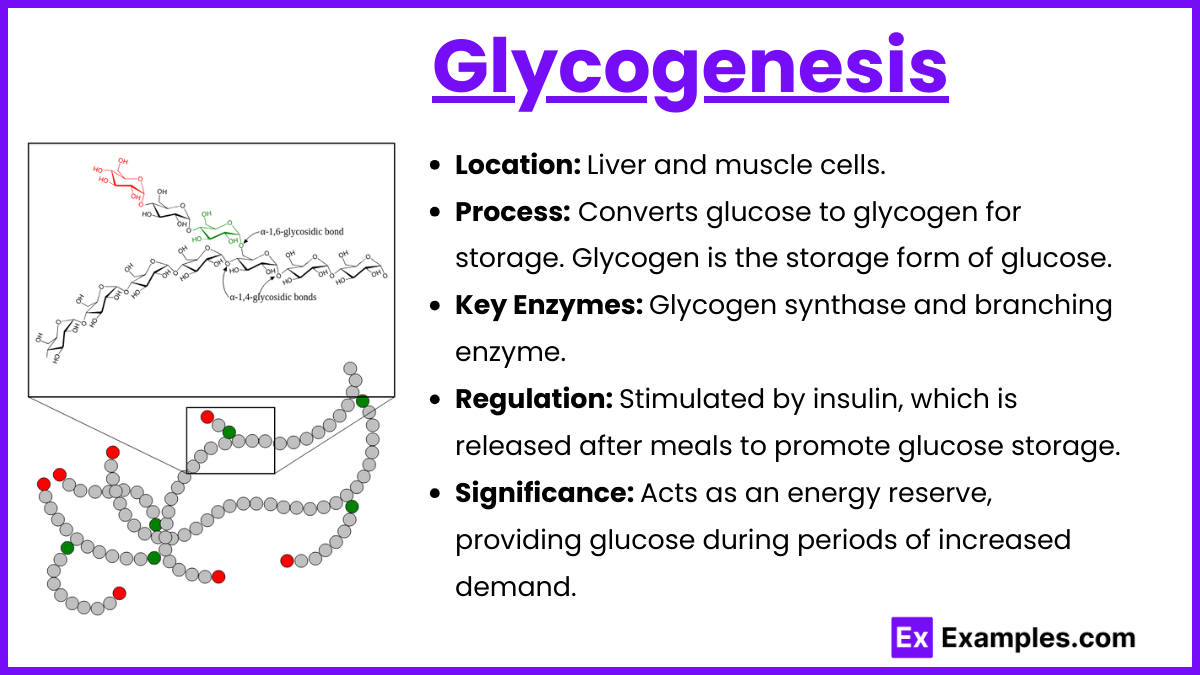
- Location: Liver and muscle cells.
- Process: Converts glucose to glycogen for storage. Glycogen is the storage form of glucose.
- Key Enzymes: Glycogen synthase and branching enzyme.
- Regulation: Stimulated by insulin, which is released after meals to promote glucose storage.
- Significance: Acts as an energy reserve, providing glucose during periods of increased demand.
4. Glycogenolysis
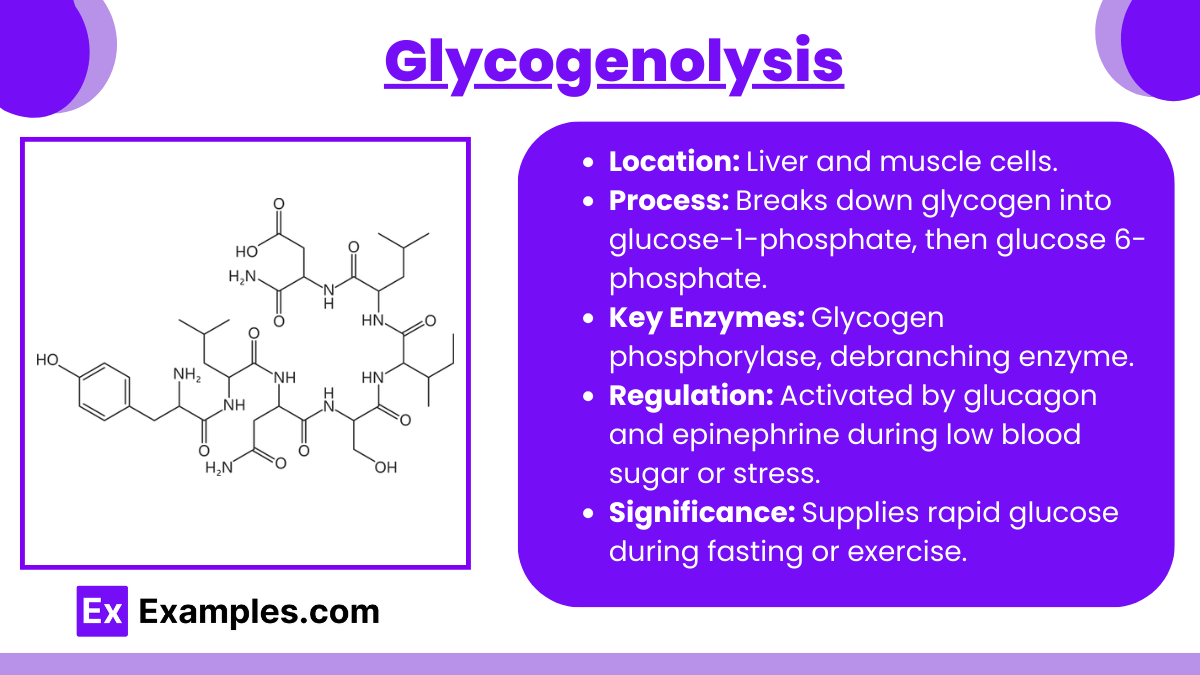
- Location: Liver and muscle cells.
- Process: The breakdown of glycogen into glucose-1-phosphate, which is then converted to glucose 6-phosphate.
- Key Enzymes: Glycogen phosphorylase and debranching enzyme.
- Regulation: Activated by glucagon and epinephrine in response to low blood sugar or stress.
- Significance: Provides a rapid release of glucose during fasting or exercise.
5. Pentose Phosphate Pathway (PPP)
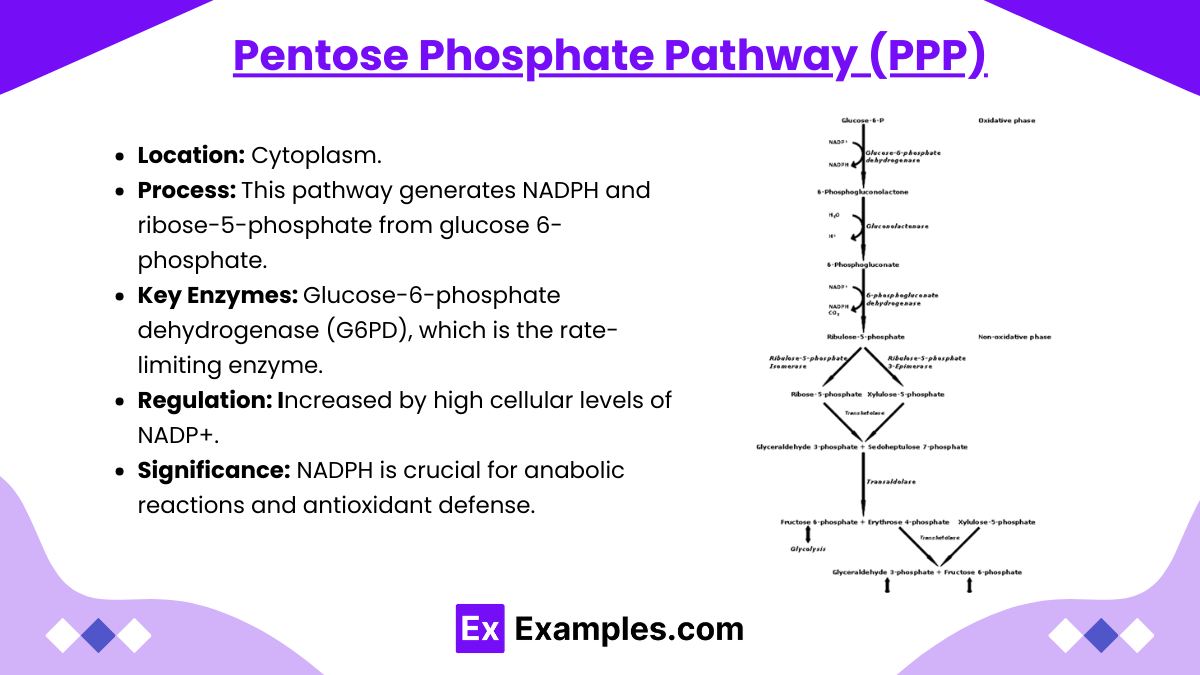
- Location: Cytoplasm.
- Process: This pathway generates NADPH and ribose-5-phosphate from glucose 6-phosphate.
- Key Enzymes: Glucose-6-phosphate dehydrogenase (G6PD), which is the rate-limiting enzyme.
- Regulation: Increased by high cellular levels of NADP+.
- Significance: NADPH is crucial for anabolic reactions and antioxidant defense.
Examples
Example 1. Energy Production During Exercise
During high-intensity exercise, muscles rely heavily on glycolysis to meet their increased energy demands. In this process, glucose is rapidly converted into ATP, the primary energy currency of cells. When oxygen is limited, as in anaerobic conditions, glycolysis produces lactate as a byproduct, which can be recycled through the Cori cycle in the liver. This rapid energy production is vital for sustaining short bursts of intense physical activity, demonstrating how carbohydrate metabolism supports muscular performance.
Example 2. Glucose Regulation During Fasting
During fasting or prolonged periods without food intake, blood glucose levels drop, triggering glycogenolysis and gluconeogenesis in the liver. Glycogenolysis breaks down stored glycogen into glucose, while gluconeogenesis synthesizes new glucose from non-carbohydrate sources like amino acids. These processes maintain blood glucose levels to supply the brain and red blood cells with constant energy, emphasizing carbohydrate metabolism’s role in blood glucose homeostasis.
Example 3. Glycogen Storage for Energy Reserve
After a carbohydrate-rich meal, insulin levels increase, stimulating glycogenesis in the liver and muscles. During this process, excess glucose is stored as glycogen, creating an energy reserve that can be used later. This reserve is crucial for times when the body requires more energy than is immediately available from circulating glucose, such as between meals or during overnight fasting, illustrating carbohydrate metabolism’s role in energy storage.
Example 4. NADPH Production for Antioxidant Defense
The pentose phosphate pathway (PPP), a component of carbohydrate metabolism, produces NADPH, an important reducing agent. NADPH plays a crucial role in protecting cells from oxidative damage by maintaining the reduced state of glutathione, a major cellular antioxidant. This aspect of carbohydrate metabolism is essential for protecting cells, particularly red blood cells, from reactive oxygen species, demonstrating its role in cellular defense mechanisms.
Example 5. Supporting Brain Function and Mental Performance
The brain primarily relies on glucose as its energy source because it cannot store glycogen or use fatty acids effectively. Carbohydrate metabolism ensures a steady supply of glucose to the brain, even during times of fasting, through gluconeogenesis and glycogenolysis. This continuous glucose supply supports cognitive functions, including memory, concentration, and learning, making carbohydrate metabolism critical for maintaining mental performance.
Practice Questions
Question 1
Which of the following enzymes is responsible for converting glucose to glucose-6-phosphate in the first step of glycolysis?
A) Hexokinase
B) Phosphofructokinase
C) Pyruvate kinase
D) Glucose-6-phosphatase
Correct Answer: A) Hexokinase
Explanation: Hexokinase catalyzes the phosphorylation of glucose to glucose-6-phosphate, the first step in glycolysis. This reaction is essential to trap glucose inside the cell for further metabolism. The addition of a phosphate group not only prevents glucose from diffusing out of the cell but also makes it more reactive for subsequent enzymatic reactions in glycolysis. Phosphofructokinase and pyruvate kinase are also enzymes in glycolysis but act at later steps, while glucose-6-phosphatase is involved in gluconeogenesis, converting glucose-6-phosphate back to glucose.
Question 2
Which process allows glucose to be synthesized from non-carbohydrate sources during prolonged fasting or intense exercise?
A) Glycolysis
B) Gluconeogenesis
C) Glycogenolysis
D) Beta-oxidation
Correct Answer: B) Gluconeogenesis
Explanation: Gluconeogenesis is the metabolic process that produces glucose from non-carbohydrate sources, such as lactate, amino acids, and glycerol. This process is critical during periods of fasting, starvation, or intense exercise when glucose levels need to be maintained, and glycogen stores are depleted. It primarily takes place in the liver and, to a lesser extent, in the kidneys. Glycolysis breaks down glucose for energy, glycogenolysis breaks down glycogen to release glucose, and beta-oxidation is the process of fatty acid breakdown.
Question 3
In the electron transport chain, which molecule derived from carbohydrate metabolism donates electrons to Complex I?
A) ATP
B) NADH
C) FADH2
D) Acetyl-CoA
Correct Answer: B) NADH
Explanation: NADH, produced during glycolysis, the citric acid cycle, and other metabolic processes, donates electrons to Complex I in the electron transport chain (ETC). This donation initiates a series of redox reactions that ultimately lead to ATP production through oxidative phosphorylation. FADH2 also donates electrons but at Complex II, not Complex I. Acetyl-CoA enters the citric acid cycle to generate NADH and FADH2, while ATP is the end product of the ETC, not an electron donor.
Preparing for the MCAT involves mastering carbohydrate metabolism, a fundamental concept in biochemistry. This topic encompasses the breakdown, synthesis, and regulation of carbohydrates, focusing on processes such as glycolysis, gluconeogenesis, glycogenesis, and glycogenolysis. It also includes understanding how carbohydrates are utilized to produce ATP and how they are regulated by hormones like insulin and glucagon. A strong grasp of carbohydrate metabolism is crucial for achieving a high score on the MCAT, as it is closely linked to energy production, cellular communication, and metabolic homeostasis.
Learning Objectives
When studying "Carbohydrate Metabolism" for the MCAT, your learning objectives should include a detailed understanding of how carbohydrates are digested, absorbed, and metabolized to provide energy to cells. You should focus on mastering the pathways of glycolysis, glycogenesis, glycogenolysis, gluconeogenesis, and the citric acid cycle, with an emphasis on their steps, regulation, and integration in energy production. Additionally, learn about the roles of enzymes, coenzymes, and intermediates in these pathways, as well as how hormones like insulin and glucagon regulate carbohydrate metabolism. Grasping the differences between aerobic and anaerobic conditions, ATP yield calculations, and the role of carbohydrates in various physiological states (e.g., fasting, exercise) is essential for the MCAT.
Key Processes of Carbohydrate Metabolism
1. Glycolysis

Location: Cytoplasm of cells.
Process: Glycolysis is the initial pathway of glucose metabolism, converting one glucose molecule (6-carbon) into two pyruvate molecules (3-carbon), generating a small amount of ATP and NADH.
Key Enzymes: Hexokinase, phosphofructokinase-1 (PFK-1), and pyruvate kinase.
Regulation: PFK-1 is the rate-limiting enzyme, regulated by ATP levels and the presence of fructose 2,6-bisphosphate.
Significance: Produces ATP anaerobically (without oxygen) and provides intermediates for other metabolic pathways.
2. Gluconeogenesis

Location: Liver and, to a lesser extent, kidneys.
Process: This is the synthesis of glucose from non-carbohydrate sources (e.g., lactate, amino acids, glycerol), occurring when blood glucose levels are low.
Key Enzymes: Pyruvate carboxylase, PEP carboxykinase, fructose 1,6-bisphosphatase, and glucose 6-phosphatase.
Regulation: Activated by glucagon and cortisol during fasting; inhibited by insulin.
Significance: Maintains blood glucose levels during fasting and intense exercise.
3. Glycogenesis

Location: Liver and muscle cells.
Process: Converts glucose to glycogen for storage. Glycogen is the storage form of glucose.
Key Enzymes: Glycogen synthase and branching enzyme.
Regulation: Stimulated by insulin, which is released after meals to promote glucose storage.
Significance: Acts as an energy reserve, providing glucose during periods of increased demand.
4. Glycogenolysis

Location: Liver and muscle cells.
Process: The breakdown of glycogen into glucose-1-phosphate, which is then converted to glucose 6-phosphate.
Key Enzymes: Glycogen phosphorylase and debranching enzyme.
Regulation: Activated by glucagon and epinephrine in response to low blood sugar or stress.
Significance: Provides a rapid release of glucose during fasting or exercise.
5. Pentose Phosphate Pathway (PPP)

Location: Cytoplasm.
Process: This pathway generates NADPH and ribose-5-phosphate from glucose 6-phosphate.
Key Enzymes: Glucose-6-phosphate dehydrogenase (G6PD), which is the rate-limiting enzyme.
Regulation: Increased by high cellular levels of NADP+.
Significance: NADPH is crucial for anabolic reactions and antioxidant defense.
Examples
Example 1. Energy Production During Exercise
During high-intensity exercise, muscles rely heavily on glycolysis to meet their increased energy demands. In this process, glucose is rapidly converted into ATP, the primary energy currency of cells. When oxygen is limited, as in anaerobic conditions, glycolysis produces lactate as a byproduct, which can be recycled through the Cori cycle in the liver. This rapid energy production is vital for sustaining short bursts of intense physical activity, demonstrating how carbohydrate metabolism supports muscular performance.
Example 2. Glucose Regulation During Fasting
During fasting or prolonged periods without food intake, blood glucose levels drop, triggering glycogenolysis and gluconeogenesis in the liver. Glycogenolysis breaks down stored glycogen into glucose, while gluconeogenesis synthesizes new glucose from non-carbohydrate sources like amino acids. These processes maintain blood glucose levels to supply the brain and red blood cells with constant energy, emphasizing carbohydrate metabolism’s role in blood glucose homeostasis.
Example 3. Glycogen Storage for Energy Reserve
After a carbohydrate-rich meal, insulin levels increase, stimulating glycogenesis in the liver and muscles. During this process, excess glucose is stored as glycogen, creating an energy reserve that can be used later. This reserve is crucial for times when the body requires more energy than is immediately available from circulating glucose, such as between meals or during overnight fasting, illustrating carbohydrate metabolism's role in energy storage.
Example 4. NADPH Production for Antioxidant Defense
The pentose phosphate pathway (PPP), a component of carbohydrate metabolism, produces NADPH, an important reducing agent. NADPH plays a crucial role in protecting cells from oxidative damage by maintaining the reduced state of glutathione, a major cellular antioxidant. This aspect of carbohydrate metabolism is essential for protecting cells, particularly red blood cells, from reactive oxygen species, demonstrating its role in cellular defense mechanisms.
Example 5. Supporting Brain Function and Mental Performance
The brain primarily relies on glucose as its energy source because it cannot store glycogen or use fatty acids effectively. Carbohydrate metabolism ensures a steady supply of glucose to the brain, even during times of fasting, through gluconeogenesis and glycogenolysis. This continuous glucose supply supports cognitive functions, including memory, concentration, and learning, making carbohydrate metabolism critical for maintaining mental performance.
Practice Questions
Question 1
Which of the following enzymes is responsible for converting glucose to glucose-6-phosphate in the first step of glycolysis?
A) Hexokinase
B) Phosphofructokinase
C) Pyruvate kinase
D) Glucose-6-phosphatase
Correct Answer: A) Hexokinase
Explanation: Hexokinase catalyzes the phosphorylation of glucose to glucose-6-phosphate, the first step in glycolysis. This reaction is essential to trap glucose inside the cell for further metabolism. The addition of a phosphate group not only prevents glucose from diffusing out of the cell but also makes it more reactive for subsequent enzymatic reactions in glycolysis. Phosphofructokinase and pyruvate kinase are also enzymes in glycolysis but act at later steps, while glucose-6-phosphatase is involved in gluconeogenesis, converting glucose-6-phosphate back to glucose.
Question 2
Which process allows glucose to be synthesized from non-carbohydrate sources during prolonged fasting or intense exercise?
A) Glycolysis
B) Gluconeogenesis
C) Glycogenolysis
D) Beta-oxidation
Correct Answer: B) Gluconeogenesis
Explanation: Gluconeogenesis is the metabolic process that produces glucose from non-carbohydrate sources, such as lactate, amino acids, and glycerol. This process is critical during periods of fasting, starvation, or intense exercise when glucose levels need to be maintained, and glycogen stores are depleted. It primarily takes place in the liver and, to a lesser extent, in the kidneys. Glycolysis breaks down glucose for energy, glycogenolysis breaks down glycogen to release glucose, and beta-oxidation is the process of fatty acid breakdown.
Question 3
In the electron transport chain, which molecule derived from carbohydrate metabolism donates electrons to Complex I?
A) ATP
B) NADH
C) FADH2
D) Acetyl-CoA
Correct Answer: B) NADH
Explanation: NADH, produced during glycolysis, the citric acid cycle, and other metabolic processes, donates electrons to Complex I in the electron transport chain (ETC). This donation initiates a series of redox reactions that ultimately lead to ATP production through oxidative phosphorylation. FADH2 also donates electrons but at Complex II, not Complex I. Acetyl-CoA enters the citric acid cycle to generate NADH and FADH2, while ATP is the end product of the ETC, not an electron donor.

